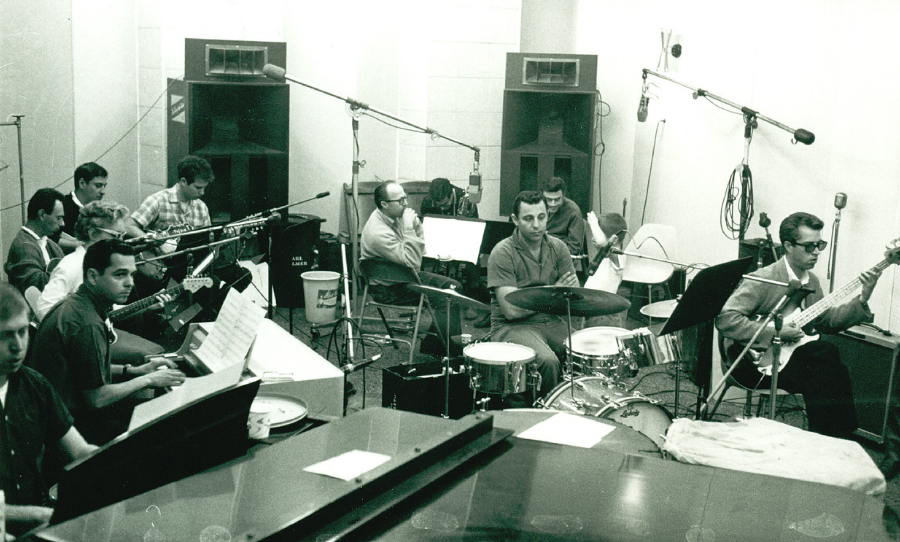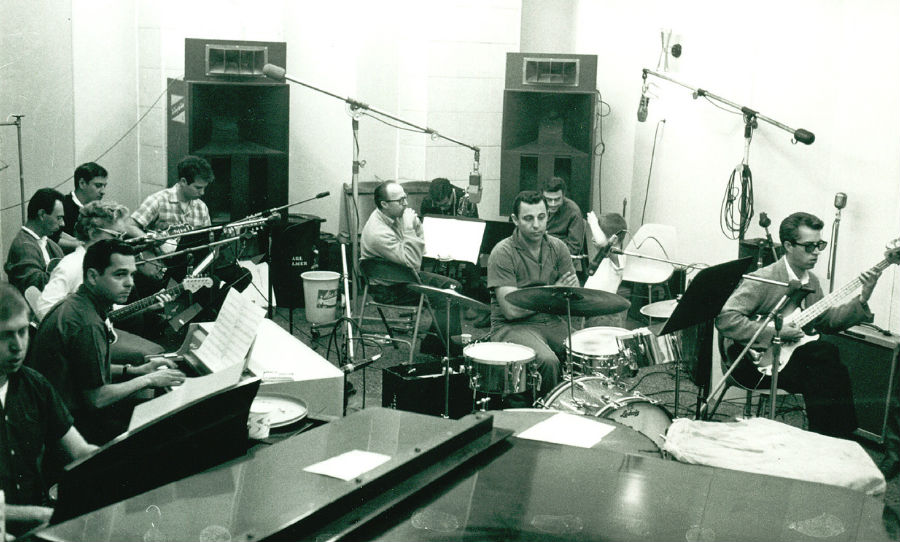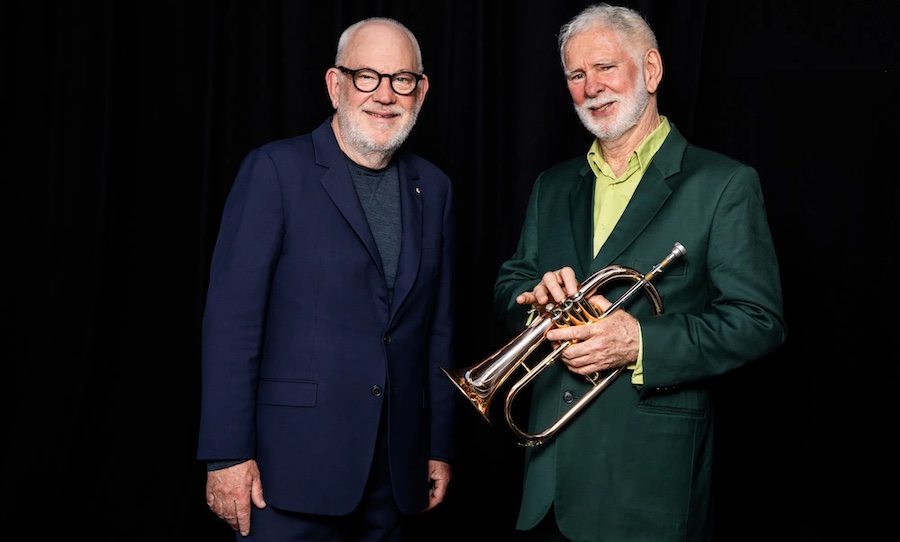The Wrecking Crew are behind some of the biggest hits of ’60s and ’70s having pressed thousands of records. They were the pop producing machine of the time.
Even if you’re scratching your head at who The Wrecking Crew is, you know who they are. If you’re familiar with any classic hits from the ’60s through to the mid-’70s, it’s likely you have felt their impact. First employed by Phil Spector for his iconic ‘Wall Of Sound’ production, then later by Brian Wilson and The Beach Boys, they have certainly imprinted the zeitgeist sound of the 1960s.
The most prolific session band of all time, this is the tale of The Wrecking Crew.

Origins
In the days of The Wrecking Crew, session groups were highly localised and highly in demand. Each scene or label had its own group, such as The Nashville A-Team, as well as two groups in Memphis; the Memphis Boys and the musicians who backed Stax Records, and the Funk Brothers in Detroit, who played on many Motown recordings.
While multi-track recording was common in the ’60s it was elaborate, and instrumental tracks were often recorded hot with a live ensemble. Thus producers needed to rely on world-class musicians and have them on call whenever there was a part to play. Furthermore, studios were frequently booked around the clock and session time was highly expensive. Songs had to be recorded quickly in the fewest takes possible.
At the time Los Angeles was widely considered the leading recording destination in the United States and the ‘go to’ team in Los Angeles was The Wrecking Crew.
The Wrecking Crew
The Los Angeles elites came to encompass a wide family of regulars. However, a few names that became notorious for their efficiency are drummer extraordinaire Hal Blaine (who coined the name), bassist and guitarist Carol Kaye (one of the few female session players of her era), guitarist Tommy Tedesco, and dozens of other musicians including Earl Palmer, Barney Kessel, Plas Johnson, Al Casey, Glen Campbell, James Burton, Leon Russell, Larry Knechtel, and Jack Nitzsche.
The Wrecking Crew were ‘the band’ of the 1960s. Thoroughly trained in either jazz or classical all players were exceptional at sight reading.
They were involved with countless acts, from Nat King Cole and Frank Sinatra to Elvis Presley and The Ronettes. They were Herb Alpert’s Tijuana Brass, Phil Spector’s ‘Wall of Sound’, as well as The Monkees and The Partridge Family. Initially, they were even The Byrds.
Just a few famous tunes that involved The Wrecking Crew include: Nancy Sinatra’s These Boots Are Made For Walking, Simon and Garfunkel Bridge Over Troubled Water, The Association Windy, the Mamas and the Papas California Dreamin’, Frank Sinatra Strangers in the Night, The Monkees Last Train to Clarksville, or Sonny and Cher Bang Bang – not to mention the Batman theme, the Mission: Impossible theme, the Hawaii Five-O theme.
Columbia Records executives deemed that the Byrds band members David Crosby, Chris Hillman, Gene Clark and Mike Clarke were not polished enough to play on their #1 debut single Mr. Tambourine Man, so in came the chart-busting Wrecking Crew.
Despite being jazz trained, The Wrecking Crew were more than happy to make the transition to rock n’ roll.
Keyboardist Don Randi said, “We were all starving. You could make more money playing rock and roll than jazz any day.”
“Very rarely did we have parts totally written out for us,” explained Randi. “We made our own parts, our own arrangements. By giving us the freedom, I think that’s where all the better records came from.”
“Everyone donated lines. Like jazz players, we did it together,” said Carole Kaye. The only female player in what was more or less a mans world, Kaye really held her own and proved herself as a leading musician in The Wrecking Crew.
Brian Wilson credits Kaye for presenting leading creative parts for California Girls as well as the iconic bassline for Good Vibrations. In 1957, Kaye was playing as a jazz guitarist when she was invited to do studio work. Her first session produced Ritchie Valens’ hit La Bamba.
“When I started to do the Ritchie Valens stuff, I missed playing bebop jazz. I started doing rock bass on guitar, and I just didn’t like it. But, he was so nice to be around, and he appreciated the studio guys. I thought if they were all like this, then I’m staying in the studio work.”
“Without a good bass line, the tune doesn’t pop. You know, it doesn’t snap like a big hit record,” Kaye said when describing her contribution to Sonny And Cher’s 1967 hit The Beat Goes On. According to Kaye, the original bass line “laid there like a dead dog.”
Depending on what the session required, members of The Wrecking Crew could switch from rock, pop, R&B, blues, Latin and jazz at a moments notice, which is precisely why the team became so busy.
While sex, drugs and rock n’ roll were practically pre-requisites for acts of those days, particularly of the jazz variety, The Wrecking Crew were an exception to the rule.
“To clear up that myth, there were none,” said Hal Blaine. “In the ’60s, nobody in the studio used drugs,” Kaye confirms. “We could cut a hit album in six hours.”
By the ’70s however, it was a completely different story and the end of an era. “Then it took a month to cut an album,” Kaye concluded with a laugh.
Legacy
For all of their immense work and talent, The Wrecking Crew were never credited on record covers. Not even for saxophonist Plas Johnson who cut the theme to Pink Panther.
But they didn’t burn out yet. They played on into the early ’70s, elevating hits such as the 5th Dimension’s One Less Bell To Answer, the Partridge Family’s I Think I Love You, and Cher’s Gypsies, Tramps, and Thieves.
By this point, several Wreckers such as Glen Campbell, Leon Russell, and Dr. John had gone onto enjoy highly successful solo careers. Others such as Jim Gordon became the drummer for Derek and the Dominos.
The Wrecking Crew, by the mid-’70s, largely passed into history. A history that it created, imperfectly acknowledged but perfectly presented in hundreds of timeless American hits.



